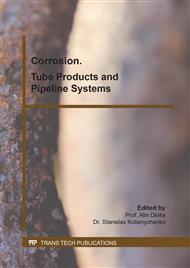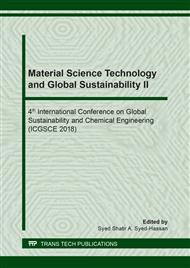p.342
p.351
p.359
p.365
p.375
p.385
p.393
p.402
p.411
Investigation on the Impact of an Enhanced Oil Recovery Polymer towards Microbial Growth and Microbial Induced Corrosion Rates
Abstract:
Some of the enhanced oil recovery (EOR) techniques involve injection of polymer brine in the formation. Addition of polymer increases the viscosity causing improved sweep efficiency owing to favorable mobility factor. Microbial induced corrosion (MIC) is caused by growth of certain bacterial species in the pipeline system and the reservoir. There is possibility of MIC to occur along the water injection schemes. Sea water is considered bereft of nutrients not allowing much bacterial activity but some sessile consortia may grow on internal line surface and cause corrosion. When the sea water is injected into the formation some anaerobic consortia dominated by sulfate reducing bacteria (SRB) grow in the formation. These bacteria use oxygen present in sulfate for respiration and volatile fatty acids (VFAs) as carbon source. But after some time of water injection the formation may get depleted of VFAs thwarting bacterial growth. This study was taken up to understand impact of EOR polymer on growth of bacterial consortium. A bacterial consortia labelled as consortia II from ATCC which is tough oilfield bacteria consortia was allowed to grow with VFA (lactate or acetate), in absence of VFA and in presence of 1000 ppm of HPAM polymer. Planktonic and sessile counts were monitored over 40 days period. Results from this study showed, microbes utilized the polymer as their secondary nutrient, whenever their preferred nutrient was depleted or insufficient. SRB sessile count which was 102 cells/cm2 in nutrient depleted medium picked up a value of 106 cells/cm2 in presence of polymer. It was observed that the bacteria first utilize the available VFA source, after that a period of lull for about 5 days followed before the growth being picked up.
Info:
Periodical:
Pages:
385-392
Citation:
Online since:
March 2019
Authors:
Price:
Сopyright:
© 2019 Trans Tech Publications Ltd. All Rights Reserved
Share:
Citation:



